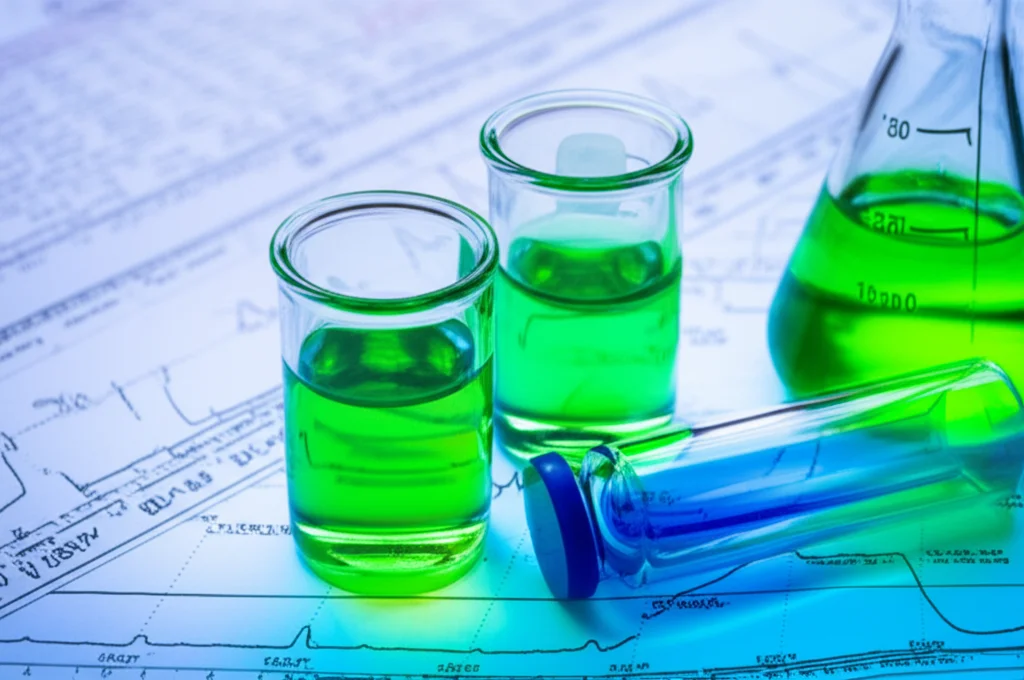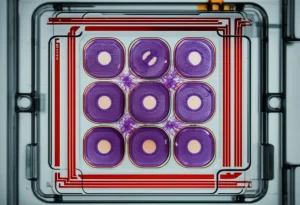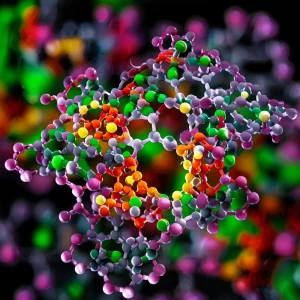Zap! Cooking Up Cool Molecules: My Adventure with Microwaves and Porphyrazines
Hey everyone! Ever wondered what us chemists get up to in the lab? Sometimes it feels like being a molecular chef, trying out new recipes to cook up fascinating new molecules. And let me tell you, my latest “dish” is a pretty exciting one: a brand-new pyrrole dicarboxylate substituted porphyrazine. Sounds like a mouthful, right? But trust me, these kinds of molecules are super interesting, and the way we made this one is pretty neat too!
So, What’s a Porphyrazine Anyway?
Imagine a beautiful, intricate molecular structure, a bit like a tiny, flat, four-leaf clover. That’s kind of what porphyrins and their cousins, porphyrazines (Pzs), look like. Porphyrazines are special because they have nitrogen atoms at key positions (the meso-positions, for you chemistry buffs) instead of carbon. This little switcheroo dramatically changes their electronic and structural personality.
The basic, unadorned porphyrazine ring can be a bit of a wallflower – it doesn’t like to dissolve well and tends to clump together (aggregate), which unfortunately dampens its cool photochemical powers. So, we chemists spend a lot of time figuring out how to jazz them up. We can do this by:
- Slotting a metal ion into the center of the “clover.”
- Attaching different chemical groups to its edges (peripheral substitution).
Lately, aminoporphyrazines – Pzs with amine groups attached – have been stealing the spotlight. They’re easier to work with, more stable, and can be tweaked for all sorts of cool applications, from medicine (think photosensitizers for therapy) to cutting-edge materials for electronics and sensors. Plus, the starting materials are relatively cheap and easy to get. Bonus!
And why pyrrole groups? Well, pyrrole rings are like a VIP pass into the world of biologically active molecules. You find them in loads of drugs, including some that fight cancer, inflammation, and even high cholesterol. So, combining pyrroles with porphyrazines? That sounded like a recipe for something special!
Going Green with a Microwave Makeover
Now, let’s talk about how we “cooked” this up. Traditional chemistry often involves long hours of heating and stirring. But we’re all trying to be a bit greener these days, right? That’s where Microwave-Assisted Organic Synthesis (MAOS) comes in. Think of it like a super-powered kitchen microwave, but for chemistry!
MAOS is fantastic because it can:
- Drastically cut down reaction times (hours to minutes!).
- Often give you more of your desired product (better yields).
- Sometimes even lead to cleaner products.
It’s more energy-efficient and cost-effective. Surprisingly, though, it hasn’t been used a ton in porphyrazine chemistry. We saw an opportunity there!
Our goal was to create this new pyrrole-substituted porphyrazine and, importantly, to develop a greener, faster MAOS method to do it. We then wanted to see how our new molecule behaved – its photophysical and electrochemical properties, its ability to generate a reactive species called singlet oxygen, and even how toxic it might be.

The Three-Step Recipe: Classical vs. Microwave
We actually made our target porphyrazine (let’s call it Pz 4 for short) and its precursor molecules using both old-school classical heating and the zippy MAOS method. This way, we could really see the difference. It was a three-step process:
Step 1: The Paal-Knorr Handshake
First, we took diaminomaleonitrile (our starting block) and reacted it with diethyl 2,3-diacetylsuccinate using a Paal-Knorr reaction. This reaction cleverly forms a pyrrole ring.
- Classical method: Stirring and refluxing in methanol for a whopping 24 hours. Yield? A decent 73%.
- MAOS method: Same ingredients, but zapped in the microwave at 120°C for just 10 minutes! And the yield shot up to an amazing 95%!
Talk about an upgrade! Ten minutes versus a whole day – I know which I prefer!
Step 2: Methylation Magic
Next, we needed to add some methyl groups to our newly formed pyrrole derivative (let’s call it compound 2).
- Classical method: This involved using sodium hydride and dimethyl sulfate, stirring from a chilly -17°C up to room temperature for 4 hours. We got our methylated product (compound 3) in 68% yield. (We had to be careful here, as sodium hydride can release hydrogen gas, which is a no-go in a sealed microwave reactor).
- MAOS method: For safety and efficiency in the microwave, we switched things up, using iodomethane and cesium carbonate. A quick 20 minutes at 120°C in the microwave, and boom – 84% yield!
Again, MAOS for the win with speed and yield, even with slightly different ingredients for safety.
Step 3: The Grand Finale – Ringing in the Porphyrazine!
This is where the magic really happens: the Linstead macrocyclization. We take four units of our methylated maleonitrile (compound 3) and encourage them to join hands to form the big porphyrazine ring, with a magnesium ion sitting pretty in the middle.
- Classical method: This involved cooking compound 3 with magnesium butoxide in n-butanol under reflux for 20 long hours. The yield for our final porphyrazine Pz 4 was 19%.
- MAOS method: Same starting materials, but into the microwave it went! At 180°C, the reaction was done in an incredible 8 minutes. Eight! And the yield jumped to 28%.
The difference is just stunning. Reducing a 20-hour reaction to 8 minutes while also getting more product? That’s the power of MAOS, and it’s a big step towards more sustainable chemistry.
Getting to Know Our New Molecule: Pz 4’s Personality
Okay, so we made this cool new porphyrazine, Pz 4. But what can it do? We put it through a whole battery of tests.
Shedding Light on Pz 4: Absorption and Emission
Using UV-Vis spectrophotometry, we saw that Pz 4 has the characteristic absorption bands we expect for porphyrazines – a strong “Soret” or B band and a “Q” band. Excitingly, it followed the Beer-Lambert law perfectly, meaning it doesn’t clump together (aggregate) in the solvents we tested (DMF and DMSO). This is great because aggregation can kill its useful properties. Its fluorescence (when it re-emits light after being excited) was moderate, similar to other well-behaved pyrrolyl Pzs. The small difference between the light it absorbs and the light it emits (Stokes shift) tells us its shape doesn’t change much when it gets excited – a good sign of stability.

Electric Personality: How Pz 4 Handles Charge
We used techniques called cyclic voltammetry (CV) and differential pulse voltammetry (DPV) to see how Pz 4 reacts to electrical potentials. We found it undergoes three main redox processes (gaining or losing electrons). Because it has a magnesium ion in the center (which is electrochemically quiet), these processes happen on the ligand itself.
Interestingly, Pz 4 is quite easy to oxidize (lose an electron). Its first oxidation happens at a pretty low potential. This is thanks to the dimethylamine groups we have on the periphery; they are strong electron-donating groups that make it easier to form a π-cation radical.
We even did in situ spectroelectrochemistry, which is like watching the UV-Vis spectrum change live as we apply a voltage. When we oxidized it, we saw the Q-band decrease and a new band pop up at longer wavelengths, a classic sign of porphyrazine cation formation. When we applied a negative potential to reduce it, we saw changes in the Soret band, indicating the formation of an anionic species. Super cool to see these transformations happen in real-time!
The Power of Singlet Oxygen
One of the most exciting potential applications for molecules like Pz 4 is in photodynamic therapy (PDT), where a photosensitizer absorbs light and then produces reactive oxygen species, like singlet oxygen (1O2), to kill cancer cells or harmful microbes.
So, how good is Pz 4 at making singlet oxygen? We measured its singlet oxygen quantum yield (ΦΔ) and found it to be moderate (0.23 in DMF and 0.22 in DMSO). These values are pretty decent and in line with other non-aggregating magnesium porphyrazines. This is a promising result!
Is It Safe? A Quick Toxicity Check with Microtox
Before we get too carried away with applications, especially medical ones, we need to know if our new molecule is toxic. We used the Microtox® test, which uses bioluminescent bacteria (Aliivibrio fischeri). If the bacteria stop glowing as much when exposed to our compound, it means it’s toxic.
The results were really encouraging! At a concentration of 10-5 M (which is 10 µM), Pz 4 showed almost no toxicity in the dark. The bacteria were still happily glowing. At a higher concentration (10-4 M, or 100 µM), it did show more toxicity. This low “dark toxicity” at relevant concentrations is exactly what you want for a photosensitizer – you want it to be harmful only when you shine light on it.
Wrapping It Up: A Speedy, Green Route to a Promising Molecule
So, there you have it! We’ve successfully cooked up a new pyrrole dicarboxylate substituted magnesium porphyrazine, Pz 4. The star of the show, in many ways, was the microwave-assisted synthesis. It slashed reaction times from many hours down to mere minutes and significantly boosted our yields. We’re talking about going from a 20-hour slog to an 8-minute zap for the final step, with nearly 50% more product!
Our new Pz 4 is a well-behaved molecule: it doesn’t aggregate, it has interesting electrochemical properties, it generates singlet oxygen moderately well, and it shows low toxicity in the dark at useful concentrations. All these features make it a really interesting candidate for further studies, perhaps as a photosensitizer in photodynamic applications.
It’s always a thrill to develop new molecules and find greener ways to make them. This project was a fantastic example of how modern techniques like MAOS can really revolutionize how we do chemistry, making it faster, more efficient, and more sustainable. And who knows, maybe one day molecules like Pz 4 will play a part in new therapies or technologies!
Source: Springer Nature







